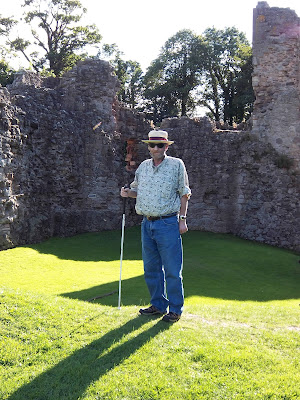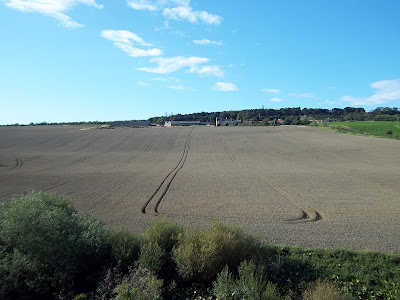I managed to persuade a friend to drive to Hailes Castle on a bright sunny afternoon over the (English Bank Holiday) weekend. The castle never fails to be an enjoyable location and I managed to clamber down to the River Tyne, with some care, and inspected a pit prison among the ruins. There are very discreet information boards in sheltered locations around the site, and there were quite a few tourists enjoying this beautifully kept location near East Linton. This can be approached from either Haddington or East Linton.
View of Hailes Castle, East Lothian
from the banks of the River Tyne
near the confluence with a burn
A great soundscape location
Prof Whitestick indicating the pit prison at Hailes Castle
East Lothian, Scotland
26 August 2012
I will be staying in
However, the final approach is via a single track road, with passing places few and far between! In the wet summer of 2011 we drove there but there was a sense of dread on the part of my friend who no doubt prayed that no vehicle suddenly appeared in the opposite direction as he drove down the narrow stretch to the castle.
The castle is in an isolated location. There are a few houses nearby and limited space for parking. However, I have been visiting Hailes Castle
Once there and safely parked, Hailes Castle
Enjoying the sun at Hailes Castle
© Professor Whitestick
Second, the castle’s isolated location has meant that the site is never crowded, so once again allowing one to discover the ruins and grounds at one’s own pace. The castle appears to be popular with some European tourists and I have heard quite a few Italian, French and German speaking visitors from time to time. This has a further advantage in that one is able to listen to and for the sounds that are a part of the castle’s setting. And it is the setting – rising, in isolation, on the banks of the River Tyne - which for me is the castle’s chief attraction and that draws me to visit it again and again over the years. There is some charm in castle ruins and Scotland
On entering the grounds one passes the small ‘bridge’ over a rushing stream near the entrance, down the pathway leading to underground chambers which were the baking house and cellars; or down a narrow flight of steps, through an arch to see and hear the river flowing and gurgling down below. Occasionally, there will be someone fishing, but always you will hear the sounds of birds – and the water, and nothing else.
Looking down on the River Tyne at Hailes Castle
© Professor Whitestick
Across, on the opposite side lies an impressive expanse of farmland which reminds me of some landscapes in the Dutch style.
View from across Hailes Castle
© Professor Whitestick
Other Historic Scotland properties include Dirleton and Tantallon Castles East Lothian walks. (http://profwhitestick.blogspot.co.uk/2012/02/east-lothian-walks-seton-collegiate.html)
Haddington is the county town and is rich in history and has an attractive river walk - a Scottish version of San Antonio , TX
NB The River Tyne is not to be confused with a river of the same name in
Hailes Castle has a connection through Lord Hailes, who styled his house near Edinburgh as Newhailes House. I wrote about my visit to Newhailes House and have decided to add two photographs of the house. The link is: http://profwhitestick.blogspot.com/2011/07/visit-to-newhailes-by-edinburgh.html





